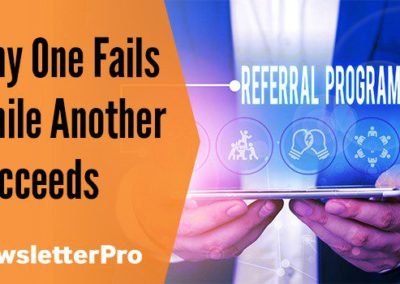Years ago, I owned a direct mail company that specialized in new-mover mailers. Our product was similar to Valpak, in that we created and distributed coupons for many different businesses, but these coupons were only mailed to new movers. When I first opened this company, my primary method of getting new business was to cold call prospects and set up appointments to meet with them.

During this time, I was often told by business owners that their company “didn’t need to advertise” — they got all the business they needed from referrals. To be honest, I was confused. For the vast majority of these meetings, I was sitting in an empty business — theirs.
So I started asking them, “Okay, what are you doing to generate all of these amazing referrals?” And the No. 1 answer I received was … “Nothing.” Many times, they would spend a good minute telling me how they had the best pizza in the area — so good that people often drive 60 miles just to grab a slice — and that’s all they needed to bring home the bacon. The second most common answer was “I ask for them … and people just refer us.”
Honestly, both answers were BS, but if I put that aside, I’ve just summed up the most common advice on how to get more referrals: 1) have a great product, and 2) ask for them. These tactics, while mildly successful, are far from a comprehensive strategy on generating referrals. So, let’s dig in and walk through a plan that is guaranteed to work.
Give before you receive.
Most businesses’ referral programs operate like this:
Dear Mr. Customer,
If you send your friends and family in, I will give you BOTH a shiny new dollar bill … that is, IF your friend or family member first decides to give me money.
Looking at this from the customer’s perspective, we are asking them to use up some of their influence with friends and family — as well as take a risk that the referred individual may or may not have a great experience with us — all for the possibility of receiving a shiny new dollar bill, which, of course, will only come once the friend or family member first gives us money.
It doesn’t really seem worth it when one of the potential outcomes is that the referral won’t have a positive experience, resulting in our customer having to hear about it over and over again.
That’s a huge risk for a customer to take — and asking for a referral in this way doesn’t really fit into natural conversation. Typically, when a referral does happen, it comes from a top-of-mind awareness, a direct question (“Do you know someone who …?”), or because of a good story. The problem is, even if you have all three, asking the person who is being referred to get up off the couch and take action is no small task. You have to provide a strong enough force to get them moving.
Provide a value ad.
Instead of making an offer for something like $25 off your customer’s next purchase when they refer someone to your business, try providing value in advance.
 If you are a dentist, you might offer a free report on the “7 Common Reasons People Get Chronic Headaches and Simple Home Remedies to Stop the Pain.” In this report, you would discuss all seven reasons, one or two of which might be TMJ disorder and teeth grinding. You would then provide solutions and home remedies to relieve the pain, as well as suggest they come and see you (or another medical provider, when appropriate) if they are experiencing certain symptoms.
If you are a dentist, you might offer a free report on the “7 Common Reasons People Get Chronic Headaches and Simple Home Remedies to Stop the Pain.” In this report, you would discuss all seven reasons, one or two of which might be TMJ disorder and teeth grinding. You would then provide solutions and home remedies to relieve the pain, as well as suggest they come and see you (or another medical provider, when appropriate) if they are experiencing certain symptoms.
Now, when a friend of your patient is complaining about headaches, your patient can say, “You know, my dentist has this free report on common headache causes and some simple ways to relieve the pain — you should get a copy.” How likely do you think their friend is to grab that free report?
At this point, the referral has been introduced to the practice and has already received some very useful information that has helped them solve a problem. The person giving the referral has provided assistance to a friend as well as an endorsement for your business. The practice has a new prospect that they know they can follow up with and get in for an appointment. Everyone wins.
This scenario is a great example of how referrals come from providing customers with care and value, instead of simply trying to make a buck. Like Zig Ziglar would say, “If you help enough people get what they want, you’ll get what you want.”
Want to build customer relationships and generate more referrals? Learn more about how newsletters will increase referrals by clicking the button and requesting a copy of our Amazon bestseller, The Ultimate Guide to Newsletters!






